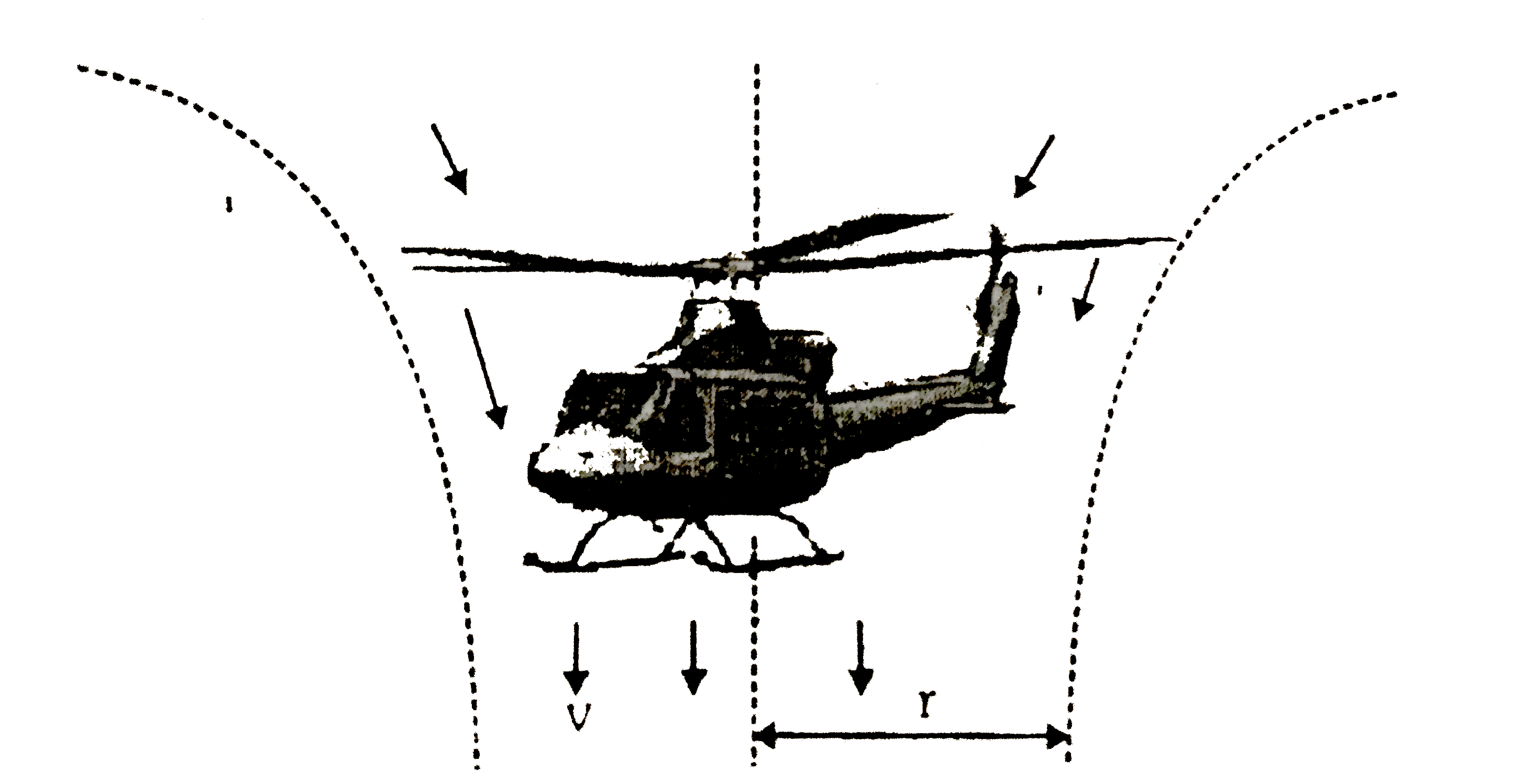The helicopter has a mass m and maintains its height by imparting a downward momentum to a column of air defined by the slipstream boundary as shown in figure. The propeller blades can project a downward air speed v, where the pressure in the stram below the blades is atmospheric and the radius of the circular cross section of the slipstream is r. Neglect any rotational energy of the air, the temperature rise due to air friction and any change in air density ρ.

If the power is doubled, the acceleration of the helicopter is :-Solution in Gujrati
(41/2)g
(41/3)g
(41/2−1)g
(41/3−1)g
The correct Answer is:D
P'=2P0=2ρAv30
Let the new velocity of air pushed down be v
ρAv30=2ρAv30
v=21/3v0
New thrust F=ρAv2
=ρA22/3v20
=(mg)41/3 [mg=ρAv20]
∴ Acceleration =a=Fnetm=Fnew−F0m
=mg41/3−mgm=(41/3−1)
Topper's Solved these Questions
- BOOK - ALLEN CHAPTER - CENTRE OF MASSEXERCISE - EXERCISE-IV A32videos
CENTRE OF MASS
- BOOK - ALLEN CHAPTER - CENTRE OF MASSEXERCISE - EXERCISE-IV B14videos
CENTRE OF MASS
- BOOK - ALLEN CHAPTER - CENTRE OF MASSEXERCISE - EXERCISE-II43videos
CENTRE OF MASS
- BOOK - ALLEN CHAPTER - BASIC MATHEMATICS USED IN PHYSICS &VECTORS EXERCISE - EXERCISE-IV ASSERTION & REASON11videos
BASIC MATHEMATICS USED IN PHYSICS &VECTORS
- BOOK - ALLEN CHAPTER - ELASTICITY, SURFACE TENSION AND FLUID MECHANICSEXERCISE - Exercise 5 B (Integer Type Questions)3videos
ELASTICITY, SURFACE TENSION AND FLUID MECHANICS
Similar Questions
Fig. shown a uniform square plate from identical squares at the corners can be removed. (a) Where is the centre of mass of the plate originally ? (b) Where is it after square 1 is removed ?
(c ) where is it after squares 1 and 2 are removed ? (d) Where is c.m after squares 1,2,3, are removed ?
(f) Where is c.m after all the four squares are removed ? Answer in terms of quadrants and axes.
 03:00View Solution
03:00View SolutionA bullet of mass M is fired with a velocity 50m/s at an angle with the horizontal. At the highest point of its trajectory, it collides head-on with a bob of mass 3M suspended by a massless string of length 10/3 metres and gets embeded in the bob. After the collision, the string moves through an angle of 120∘. Find
(i) the angle θ,
(ii) the vertical and horizontal coordinates of the initial position of the bob with respect to the point of firing of the bullet. Take g=10m/s205:36View SolutionTwo particle A and B start moving due to their mutual interaction only. If at any tiem 't', →aA and →aB are their respective accelerations, →vA and →vB are their respective velocities, and upto that time WA and WB are the work done on A and B respectively by the mutual force, mA and mB are their masses respectively, then which of the following is alwys correct.
02:05View SolutionAssertion: If the initial and final positions coincide, the displacement is a null vector.
Reason: A physical quantity can not be called a vector, if its magnitude is zero.04:15View SolutionTwo soap bubbles A and B are kept in a closed chamber where the air is maintained at pressure 8N/m2.The radii of bubbles A and B are 2cm and 4cm, respectively. Surface tension of the soap-water used to make bubbles is 0.04N/m. Find tha ratio nB/nA, where nA and nB are the number of moles of air in bubbles A and B, respectively. [Neglect the effect of gravity.]
02:04View SolutionTwo balls of different masses are thrown vertically upwards with the same speed . They pass through the point of projection in their downward motion with the same speed ( Neglect air resistance ).
02:10View SolutionA quill tube contains a mercury column of length 19cm . The length of air column is 24cm when it is held veritcally. On inverting it with its open end downwards the length of air column will be (atmospheric pressure = 76cm of Hg )
02:13View SolutionCO2 can be clooected by the downward displacement of air.
02:37View SolutionA bomb is falling vertically downwards into the air it explodes in air, then
View SolutionPropeller blades, 2 m long , ar e rotating at 1800 rpm. What is the linear speed of the tip of the blades ?
01:44View SolutionA : Speed of sound in moist air is more than its speed in dry air . R : Dry air is denser than moist air at atmospheric pressure .
View SolutionThe blades of a windmill sweep out a circle of area A. What is the kinetic energy of the air?
04:15View SolutionThe blades of a windmill sweep out a circle of area A. What is the kinetic energy of the air?
02:21View SolutionThe blades of a windmill sweep out a circle of area A. What is the kinetic energy of the air?
02:05View SolutionThe blades of a windmill sweep out a circle of area A. What is the kinetic energy of the air?
01:31View Solution(A):Two balls of different masses are thrown vertically upward with same speed,they will pass through their point of projection in the downward direction with the same speed . (neglect air resistance)
(R ):The maximum height and downward velocity attained at the point of projection are independent of the mass of the ball.02:01View Solution

